The condition of our skin is one of the most important indicators of health, this should not be forgotten, especially on hot days. The summer period favors pustular diseases, which are caused by various microorganisms. In this article, we will talk about folliculitis . - inflammation of the hair follicles, that is, tiny epidermal structures located in the dermis at the root of each hair.
What are the causes of folliculitis?
The causes responsible for this disease are many and not always easy to identify. In most cases, the disease can be caused by infections: bacterial (Staphylococcus aureus, Pseudomonas aeruginosa); fungal ( Candida albicans , Trichophyton rubrum , Tinea capitis ); viral (herpes simplex, smallpox, molluscum contagiosum).
The most common form of infectious folliculitis is caused by Staphylococcus aureus. This microorganism is a saprophyte, constantly present on the skin and mucous membranes, which under normal conditions does not cause concern. However, in certain cases, it can multiply uncontrollably, causing inflammation.
Risk factors in relation to folliculitis are: excessive sweating, occlusion of hair follicles caused by wearing tight clothing, shaving against hair growth, immunosuppression , diabetes mellitus, obesity, insect bites, iron deficiency anemia. In some patients, the underlying cause of folliculitis, especially its recurrent form, remains an unresolved issue ( idiopathic nature of the problem).
Folliculitis is a common dermatological disease that can occur at any age in both men and women. The disease can affect any area of \u200b\u200bthe skin on which hair grows. Since men shave frequently, folliculitis in men tends to occur predominantly in the beard area.
How does folliculitis manifest itself?
The most common form, superficial folliculitis, begins with red boils and/or small, pus-filled pustules near the follicles. The size of the pustules depends on the depth of the infection and the extent of the damage. Sometimes small purulent vesicles with a classic yellow head can be observed on the skin, which, when opened, leave small crusts. Redness and itching are recurring symptoms in the context of superficial folliculitis, pain and scarring occur when the deeper layers of the skin are drawn into the inflammatory process.
How to treat folliculitis?
Therapy depends on the type of folliculitis and the extent of the lesion. Therefore, before proceeding with treatment, it is necessary to establish the pathogen, and laboratory diagnostics cannot be dispensed with. As mentioned above, the disease can be triggered by various types of microorganisms, such as bacteria, viruses or fungi. Thus, the therapy for each of these infections varies depending on the pathogen. A dermatologist at Bogolyuby Medical Center will help you choose, if necessary, a competent and effective therapeutic strategy.
Superficial folliculitis requires meticulous hygiene and the use of only neutral and very gentle soaps. In the case of deep lesions, topical and oral antibiotics are the most appropriate treatment. Pseudomonas folliculitis usually resolves on its own and does not always require pharmacological intervention. Herpetic folliculitis is treated with antiviral drugs such as valacyclovir , famciclovir , or acyclovir . In the case of fungal folliculitis, the doctor prescribes antimycotic agents, such as fluconazole and econazole . The peculiarity of fungal folliculitis is that it is prone to frequent relapses. For this reason, the patient must continue local antifungal therapy for a certain time even after the symptoms disappear. Immunocompromised patients with non-infectious folliculitis may benefit from immunostimulants plus cortisone therapy .

















